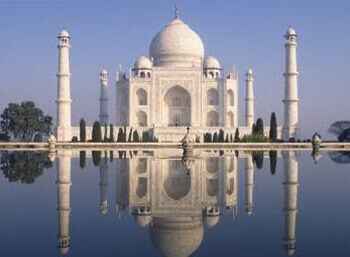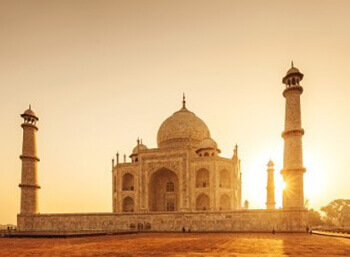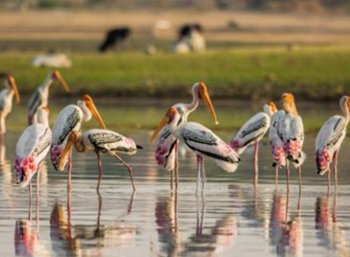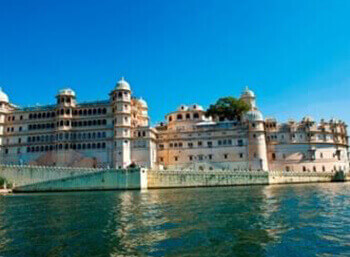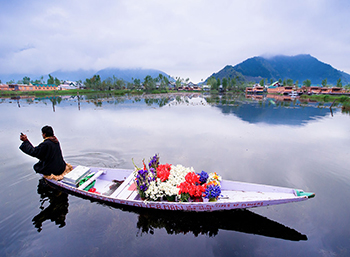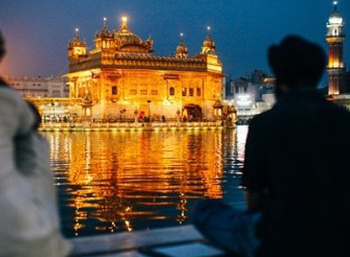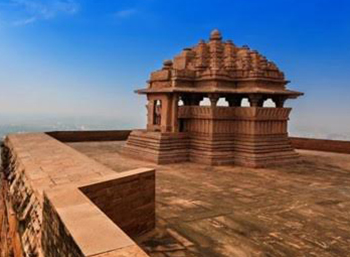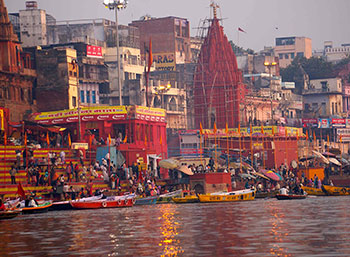Amazing Agra Tour
Taj Mahal
History of Taj Mahal
The Taj Mahal of Agra is one of the Seven Wonders of the World, for reasons more than just looking magnificent. It's the history of Taj Mahal that adds a soul to its magnificence: a soul that is filled with love, loss, remorse, and love again. Because if it was not for love, the world would have been robbed of a fine example upon which people base their relationships. An example of how deeply a man loved his wife, that even after she remained but a memory, he made sure that this memory would never fade away. This man was the Mughal Emperor Shah Jahan, who was head-over-heels in love with Mumtaz Mahal, his dear wife. She was a Muslim Persian princess (her name Arjumand Banu Begum before marriage) and he was the son of the Mughal Emperor Jehangir and grandson of Akbar the Great. It was at the age of 14 that he met Mumtaz and fell in love with her. Five years later in the year 1612, they got married.
Mumtaz Mahal, an inseparable companion of Shah Jahan, died in 1631, while giving birth to their 14th child. It was in the memory of his beloved wife that Shah Jahan built a magnificent monument as a tribute to her, which we today know as the "Taj Mahal". The construction of Taj Mahal started in the year 1631. Masons, stonecutters, inlayers, carvers, painters, calligraphers, dome-builders and other artisans were requisitioned from the whole of the empire and also from Central Asia and Iran, and it took approximately 22 years to build what we see today. An epitome of love, it made use of the services of 22,000 laborers and 1,000 elephants. The monument was built entirely out of white marble, which was brought in from all over India and central Asia. After an expenditure of approximately 32 million rupees, Taj Mahal was finally completed in the year 1653.
It was soon after the completion of Taj Mahal that Shah Jahan was deposed by his own son Aurangzeb and was put under house arrest at nearby Agra Fort. Shah Jahan, himself also, lies entombed in this mausoleum along with his wife. Moving further down the history, it was at the end of the 19th century that British Viceroy Lord Curzon ordered a sweeping restoration project, which was completed in 1908, as a measure to restore what was lost during the Indian rebellion of 1857: Taj being blemished by British soldiers and government officials who also deprived the monument of its immaculate beauty by chiseling out precious stones and lapis lazuli from its walls. Also, the British style lawns that we see today adding on to the beauty of Taj were remodeled around the same time. Despite prevailing controversies, past and present threats from Indo-Pak war and environmental pollution, this epitome of love continuous to shine and attract people from all over the world
Taj Mahal Mosque
Enhancing the already present splendor of the Taj Mahal is a building that stands on the western side of it, a Mosque made up of red sandstone. It serves two purposes, first, it was obligatory according to the Muslim law for each mausoleum to have a place of worship nearby; second, the mosque and a mirror image of the mosque, a guest house that stands on the opposite side of it, together provide a perfect symmetrical balance to the architecture of whole of Taj Mahal. Used for prayer purpose, the mosque faces the direction of the holy city of Mecca and is believed to have been built by Isa Mohammad. The exterior possesses one dominant portal known as an Iwan and on either side of it are two smaller arches. Three marble coated domes and four little domed kiosks with marble veneer make up for the splendid visuals of the mosque, a design that is similar to others built by Shah Jahan, particularly to his Masjid-Jahan Numa, or Jama Masjid, Delhi.
The interiors host an elegantly designed floor that is made up of a material that appears to be velvet red in shade and is in the shape of clearly defined prayer mats, 569 prayer mats in total. The interiors of the mosque are inscribed with delicate calligraphy citing the name Allah and quotations from scriptures (taken from Sura 91, The Sun, taken from the holy book of Quran). However, the main feature of the mosque that distinguishes it from the opposite structure of the guest house is the presence of Mihrab and Minbar. The Mihrab is an indented enclosure that indicates the direction of Mecca and the direction which the Muslims face to perform their prayers or salat. The place from where the priest delivers a speech is known as Minbar and is always positioned to the right hand side of the Mihrab and consists of three steps to a flat platform.
Additionally, there lies a small stone enclosed space of 19 ft by 6.5 ft, which had served as a temporary grave where the remains of Mumtaz Mahal were kept for some time when they were first brought to Agra, until they finally found an eternal place of rest inside the beautiful mausoleum built in her precious memory. This enclosure is located along the western boundary wall that also houses the well of the mosque. Also, the exteriors of the mosque, crypt and cenotaphs carry pietra dura decoration of a fabulous unexcelled elegance. The name of Allah and verses from the Holy Qur'an has been used copiously all over the mosque. And the pool in front of the mosque functions as the place for ablution before the prayer. As Percy Brown, the noted art historian observes, the Taj "resembles the spirited sweep of a brush rather than the slow laborious cutting of a chisel".
Divided Into: Four Parts
State: Uttar Pradesh
Distance from Delhi: 204 Km (approx)
It's the city of Agra that has received the honor of having one of Seven Wonders of the World, the Taj Mahal: an abode for eternal Love, in its courtyard. Located in the northern state of Uttar Pradesh, India, Agra has been one powerful city since the medieval times. The city finds mention in the epic Mahabharata and later gained recognition as the capital of Mughal Empire from 1526 to 1658 under the emperors Akbar, Jahangir, and Shah Jahan. At that time, the city of Agra was also known as Akbarabad. Till date, it remains a major tourist destination, courtesy three of the most famous Mughal era buildings like Agra Fort, Fatehpur Sikri, and most notably the terrific Taj Mahal, all three of which stand as the UNESCO World Heritage Sites. The Taj Mahal in particular, built by Shah Jahan in the memory of his beloved wife Mumtaz Mahal, is one of the most recognizable buildings in the world and is visited by millions of tourists annually.
The location for Taj Mahal was clearly a well thought out decision by Shah Jahan who chose a peaceful site about one and a half miles away from Agra at the southern edge of the city at the banks of river Yamuna. This location also had a strategic importance for the emperor, as it could be seen from his palace in the Agra Fort. The closeness to the river Yamuna not only gave this location a scenic edge, but also met the need for water during construction purposes and laying out the garden. Moving on to the Taj, the entire complex consists of a number of buildings comprising of a mosque, a guesthouse and the mausoleum, housing both the tombs of Mumtaz Mahal and Shah Jahan. A long and beautiful walkway leads to the main mausoleum, which is built of pure white marble. Four waterways divide the gardens that stand in front of the Taj into four parts and then, meet in a pool at the center. It is believed that half of the beauty of Taj Mahal comes from this strategic location where it stands.
With Taj Mahal being in the premises of the Agra city and the city itself being the 19th most populous city of India, getting to it and the stupendous Taj Mahal isn't much of a problem. The Taj Mahal is located within 6 km of distance from the Agra city centre and is easily accessible by auto rickshaw or a cab. With the city being well connected by national highways, it is easily accessible through road from all major cities in India. The three railway stations: Agra Cantt, Agra Fort Railway station (from where the Taj is at 10-15 minutes of walking distance), and Raja ki Mandi connect almost all cities of the country and make access to the city of Taj an easy affair. For those who are extremely busy but still do not want to miss an opportunity to immerse themselves in the beauty of the Taj Mahal, getting to Agra by flight would be the easiest way out. Agra airport, which is around 6 km from the city centre, has Indian Airways' flights flying in and out on a daily basis
Period of Construction: 1632-1638
Referred to as Darwaza-i-Rauza or "gate of the mausoleum" by the architect Ustad Ahmad Lahauri himself, the main gateway to Taj Mahal is indeed a worthy counterpart to the mausoleum in every sense of the phrase. No doubt that Taj looks splendid when seen from distance, but it's the child-like enthusiasm to adore it from touching distance that takes the anticipations to an all new level. And just when one reaches the open square before the main gateway, the majestic view of Taj disappears completely, only to manifest itself in an altogether glorious way when one stands right in the doorway itself, the doorway to the main mausoleum. The concept of Taj emerging out of the shadows and slowly growing on you seems even more praiseworthy if one dives into the abstract interpretation that suggests a transition from the outer physical world to the inner spiritual world.
The main gateway of the Taj Mahal is one of the five main elements of this magnificent monument. Adorned with Hindu motifs, the Taj gateway is a tall niche doorway in the shape of an ogival arch that rises till the mid-height of the structure. With a vertical symmetry, the main gateway of Taj Mahal stands bordered with Arabic calligraphy of verses from the Quran, made up of black stone. An optical illusion is brilliantly at play here as the size of the letters has been increased in such a way that it all seems consistent all over the arch from top to bottom. It was done by gradually increasing the size of the letters in a pre-calculated manner as their distance from the eye increased. Also, part of this gateway are octagonal towers that stand on the corners and are surmounted with broad and open domed kiosks and a heavy door made up of eight different metals at the base that are adorned with knobs.
Further beautifying the gateway to the Taj is an image of a white teardrop with a red trident, located above the pointed tip of the niche. When the gateway was under construction, this frontal gateway served as the main entrance. All these motifs of the gateway reflect a Hindu touch. Entwined flowers, mainly red lotus ones, leaves and vines ornament the sloping sides of the niche. These motifs were formed by semi-precious stones inlaid in the marble. And within the archway of this main gateway is a huge chamber with an arched roof decoration. The experts haven't been able to unlock the mystery of the countless rooms that lay inside it which have twisting and branching and side branching hallways that were seemingly built to confuse its entrants but have been unused for three centuries. Most of all, it's the stunning view of Taj from inside the main gateway that remains etched in viewers' memories long after the show is over.
Divided Into: Four Parts
Canals: Two (crossing in the centre)
Flowerbeds: Sixteen
Trees: Cyprus & Fruit Bearing
The garden that starts from the end of the main gateway and ends near the squared base of the mausoleum is an integral part of the Taj Mahal structure and is, undeniably, one of the major highlights of the visit for many. The garden that beautifies Taj comes from the Persian Timurid style of gardens, and is based on the concept of paradise garden' and was brought in by Babur. This garden, filled with flowers, fruits, birds, leaves, symmetry, and delicacy, served many functions along with portraying strong symbolic or abstract meanings about paradise. A paradise which, according to Islamic beliefs, consists of four rivers: one of water, one of milk, one of honey, and one of wine. And it is from this concept that Char Bagh of Taj Mahal originated. Also, the symbolism of the garden and its division are noted in the Islamic texts that describe paradise as a garden filled with abundant trees, flowers, and plants.
Out of the total area of 580 meter by 300 meter of the Taj complex, these gardens alone cover an area of 300 meter by 300 meter distance and are based on geometric arrangements of nature. No attempt was made to give them a "natural" look. Another architectural attribute that has been followed in the case of the entire monument, especially the gardens of the Taj Mahal of Agra, is the usage of number four and its multiples. Since four is considered the holiest number in Islam, all the arrangements of Charbagh Garden of Taj Mahal are based on four or its multiples. The entire garden is divided into four parts, with two marble canals studded with fountains crossing in the center. In each quarter portion, there are 16 flowerbeds that have been divided by stone-paved raised pathways. It is said that even each of the flowerbed was planted with 400 plants.
The trees of the Taj garden are either that of Cyprus (signifying death) or of the fruit bearing type (signifying life) and even they are arranged in a symmetrical pattern. Taj Mahal occupies the north-end corner of the garden, instead of being in the center. In fact, at the center of the garden, between the Taj and its gateway, is a raised marble lotus-tank with a cusped border, which reflects the Taj in its waters. The four walkways that are although identical are differentiated through their context. In fact, the symmetry with which the whole garden has been organized and laid out, can be clearly observed and experienced as one can get an unhindered view of the mausoleum from any spot. These aesthetically maintained gardens not only bring a natural sense to the proceedings, but also make for some great snap taking spots.
The Taj Mahal, an embodiment of love and romance, is located in the city of Agra that lies approximately 204 km to the south of Delhi. A UNESCO World Heritage Site and one of the Seven Wonders of the World, the monument attracts hordes of domestic and international tourists from all over the world, all year round. Such is the magnetic appeal and charismatic essence of the monument that visitors can never have enough of it ever and would want to visit it time and again. In case you have made up your mind to be enthralled by the excellence of this architectural brilliance, and are planning a trip to explore the beauty of this splendid monument, then the very first question that would come to your mind in how to reach the Taj Mahal. We have devoted this section on discussing various ways of traveling to the Taj Mahal in India.
By Air
The fastest way of reaching Taj Mahal, Agra is by air. The city of Taj, Agra, has its own airport that is around 7 km from the city center. Indian Airlines operates flights to Agra on a daily basis.
By Rail
There is a good network of trains connecting Agra with the rest of the country. Apart from the main railway station of Agra Cantonment, there are other two stations also, that of Raja-ki-Mandi and Agra Fort. The main trains connecting Agra with Delhi are Palace on Wheels, Shatabdi, Rajdhani, and Taj Express.
By Road
There are regular bus services from Agra to a number of important cities. The main bus stand of Idgah has a number of buses running for Delhi, Jaipur, Mathura, Fatehpur-Sikri, etc.
Local Transportation
After reaching the city also, you need some sort of local transport to reach Taj Mahal. You can easily get taxi, tempo, auto-rickshaw and cycle rickshaw in the city that will take you to your destination. Prepaid taxis are also available if you want to visit the various places near the city. For the adventurous kind, there are bicycles that can be hired on hourly basis from different parts of the city. Since diesel and petrol vehicle are not permitted in the vicinity of Taj Mahal area, you can find battery-operated buses, horse-driven tongas, rickshaws and other pollution-free vehicles there.
October to March
Just as there's no such thing as "a bad time to live", there's no such thing as "bad time to visit" one of the most scintillating and marvelous wonders of the world, the Taj Mahal. Whatever be the time of the year, the Taj Mahal will not stop with its mission to spread its charm and glory and will continue to be as luminescent as ever. But as a visit in the months of summers requires a high threshold to bear the heat, the period between the comparatively cooler months i.e. October to March is generally considered a best time to visit the Taj Mahal. Having said that, know that the radiance of the Taj Mahal is simply dazzling, and changes with every passing hour, reflecting a different aura in different seasons. Also, the visual beauty of the Taj Mahal is at its peak during sunrise, sunset, and under the full moon night.
Taj Mahal at Sunrise
Watching the sun rise up from under the sea of sky is a sight to behold, and what better way to experience it than to watch it take its place up there while you stand on the premises of one of the Seven Wonders of the World. It's a moment of delight when the beauty of the sunrise and the Taj Mahal culminate together to make for some awe-inspiring images of the Taj, being transformed from soft grey and pink to a soft red glow.
Taj Mahal at Sunset
After shining its glory all through the day, when the sun climbs down the stairway of heavens and gets ready to say adios to the world, it plays its final trick in the book by lending Taj Mahal a different appearance with the shades of fiery yellow being transformed into soft exotic orange and finally to pearl white again, until the full moon prepares itself to accompany the Taj all through the night while dazzling the world with its quiet heavenly elegance.
Taj Mahal under Full Moon Night
By the night when the full moon is high up in the sky, the beauty that Taj Mahal breathes out is beyond the scope of words. A silver glow that takes over Taj Mahal is so mesmerizing that most of the things you'll see after that will feel ordinary at best. This fabulous interplay of colors all through the day, and then night, symbolically implies the presence of God, who is never represented in the anthropomorphic form.
The best time to arrive would be just before the sunrise or sunset. Night viewing is allowed on the full moon night, two days before it and two days after it. Tickets for the same need to be booked one day in advance.
The timings of visiting the Taj Mahal are set by the Archeological Survey of India. The Taj is opened all days of the week except for Fridays, when it is opened in the afternoon only for those who have to attend prayers at the Taj Mosque. The timings are from sunrise to sunset. Tickets are available throughout the day from the western and eastern gate, and at the southern gate tickets are available from 8:00 AM to 5:00 PM. The tourists can spend any number of hours inside the Taj complex from sunrise to sunset.
Night viewing at the Taj Mahal, from 8:30 PM to 12:30 AM, is allowed only on five nights in a month: one, on the full moon night, two days before it and two days after it, except for Fridays. However, night viewing is limited to maximum 400 people per night, divided into eight batches of 50 each and each batch is allowed to visit for a maximum duration of 30 minutes. The tickets for night viewing have to be booked one day (24 hours) in advance from the booking counter located in the office of the Archeological Survey of India, Agra Circle, 22 The Mall, Agra, Uttar Pradesh in between 10:00 AM to 6:00 PM.
Taj Mahal Timings
Timing
Every Day, (except Friday), Sunrise to Sunset
Night, 8:30 PM to 12:30 AM (On Full moon night, two days before and two days after)
Day Fee
Rs 750 (Foreigners)
Night Fee
Rs 750 (Adult, Foreign)
Rs 510 (Citizens of SAARC and BIMSTEC Countries)
Rs 20 (Indian)
Entry Free for children below 15 years of age
Rs 510 (Adult, Indian)
Rs 500 (Child 3-15 Years, Indian & Foreign)
Entry free for child below 3 years of age
Fast Facts
Built By
Shah Jahan
Dedicated to
Mumtaz Mahal (Arjumand Bano Begum), the wife of Shah Jahan
Building Type
Islamic tomb
Architecture
Mughal (Combination of Persian, Islamic and Indian architecture style)
Highlights
One of the Seven Wonders of the World; A UNESCO World Heritage Site
Architect: Ustad Ahmad Lahauri
Cost of Construction: 32 crore rupees
Number of workers: 20,000
Taj Mahal Story
- Male Protagonist : Shah Jahan (Prince Khurram)
- Female Protagonist : Mumtaz Mahal (Arjumand Banu Begum)
Taj Mahal, the magnificent monument that stands at the heart of India has a story that has been melting the hearts of millions of listeners since the time Taj has been visible. A story, that although ended back in 1631, continues to live on in the form of Taj and is considered a living example of eternal love. It's the love story of Shah Jahan and Mumtaz Mahal, two people from the course of history who set an example for the people living in present and the future to come. An English poet, Sir Edwin Arnold best describes it as "Not a piece of architecture, as other buildings are, but the proud passion of an emperor's love wrought in living stones." The story that follows next will prove why the statement is true.
Shah Jahan, initially named Prince Khurram, was born in the year 1592. He was the son of Jehangir, the fourth Mughal emperor of India and the grandson of Akbar the Great. In 1607 when strolling down the Meena Bazaar, accompanied by a string of fawning courtiers, Shah Jahan caught a glimpse of a girl hawking silk and glass beads. It was love at first sight and the girl was Mumtaz Mahal, who was known as Arjumand Banu Begum at that time. At that time, he was 14 years old and she, a Muslim Persian princess, was 15. After meeting her, Shah Jahan went back to his father and declared that he wanted to marry her. The match got solemnized after five years i.e., in the year 1612.
It was in the year 1628 that Shah Jahan became the Emperor and entrusted Arjumand Banu with the royal seal. He also bestowed her with the title of Mumtaz Mahal, meaning the "Jewel of the Palace". Though Shah Jahan had other wives also, but, Mumtaz Mahal was his favorite and accompanied him everywhere, even on military campaigns. In the year 1631, when Mumtaz Mahal was giving birth to their 14th child, she died due to some complications. While Mumtaz was on her deathbed, Shah Jahan promised her that he would never remarry and will build the richest mausoleum over her grave.
It is said that Shah Jahan was so heartbroken after her death that he ordered the court into mourning for two years. Sometime after her death, Shah Jahan undertook the task of erecting the world's most beautiful monument in the memory of his beloved. It took 22 years and the labor of 22,000 workers to construct the monument. When Shah Jahan died in 1666, his body was placed in a tomb next to the tomb of Mumtaz Mahal. This magnificent monument came to be known as "Taj Mahal" and now counts amongst the Seven Wonders of the World. This is the true story of the Taj Mahal of India, which has mesmerized many people with its bewitching beauty.
Shah Jahan
- Born On : January 5, 1592
- Died On : January 22, 1666
- Achievements : Founder of the magnificent monument Taj Mahal, Also associated with the Red Fort of Delhi, Jama Masjid of Delhi, Section of Agra Fort, the Wazir Khan Mosque and the Moti Masjid in Lahore, Pakistan
Shah Jahan, his name along with the name of his wife Mumtaz Mahal, being synonymous with the existence and ever growing popularity of Taj Mahal, was a Mughal Emperor of the Southern Asia who reigned from 1627 to 1658. Born as Prince Shihab-ud-din Muhammad Khurram in the Lahore, Pakistan of 1592, Shah Jahan was the son of Emperor Jahangir. His name Khurram, which means "joyful" in Persian, was given to him by his grandfather Akbar the Great. Displaying great military skills at an early age against numerous enemies including Mewar, the Lodi in the Deccan, and Kangra, impressed his father so much that Shah Jahan received the title "Shah Jahan Bahadur" from him. He wasn't just a sharp military leader, but also had an exceptional talent for building and proved it by re-designing buildings within the Agra fort. Among many titles he had earned, "The Builder of the Marvels" was one that was about to be proved the most deserving in the time to come.
The most significant part of Shah Jahan's life history began in 1607 when he was 15 and was betrothed to Arjumand Banu Begum, the granddaughter of a Persian noble and was just 14 at that time. After they got married in 1612, Arjumand became the unquestioned love of his life. Khurram, upon finding her appearance and character elect among all the women of the time, bestowed her with the title of Mumtaz Mahal, meaning "Jewel of the Palace". Although Mumtaz was one among the few wives Shah Jahan had had, according to the official court chronicler Qazwini, the relationship with his other wives "had nothing more than the status of marriage. The intimacy, deep affection, attention and favor which His Majesty had for the Cradle of Excellence (Mumtaz) exceeded by a thousand times what he felt for any other". She was his inseparable companion, accompanying him even on military ventures, a trusted confidante and their relationship was intense.
After she died in 1631 while giving birth to their 14th child, Shah Jahan undertook the work of constructing world's most beautiful monument in her memory. This monument, which entombs Mumtaz Mahal as well as Shah Jahan, came to be known as "Taj Mahal", the building of which took 22 years and 22000 laborers. It was in 1657 that Shah Jahan fell ill, and Dara, Mumtaz Mahal's eldest son assumed responsibility of his father's throne. His other son, Aurangzeb, accompanied by his younger brothers Shuja and Murad marched upon Agra to in order to claim their share. They defeated Dara's armies and declared their father Shah Jahan incompetent to rule and put him under house arrest in Agra Fort. After Shah Jahan died in 1666 in captivity, his body was taken quietly by two men and was laid beside Mumtaz. Apart from the Taj Mahal, one of the Seven Wonders of the World, the Red Fort of Delhi, Jama Masjid of Delhi, Section of Agra Fort, the Wazir Khan Mosque and the Moti Masjid in Lahore, Pakistan, are some of the noble structures associated with the name of Shah Jahan, meaning "King of the World" in Persian.
Mumtaz Mahal
Shah Jahan who built the Taj Mahal, a wondrous monument built in dedication to love, beauty, and life of Mumtaz Mahal, had succeeded in his lifetime his dire wish to immortalize the name of Mumtaz Mahal, his third wife. Such is the esteem of Mumtaz Mahal that she is known by one and all, who've ever heard of Taj Mahal. Born in 1593 as Arjumand Banu Begum, she was the daughter of Abdul Hasan Asaf Khan and a princess from the Persian nobility. So enthralling was her beauty that Shah Jahan (then Prince Khurram) fell in love with her at the first sight. It was in 1607 that she was betrothed to Prince Khurram and soon became the unquestionable love of his life. Five years later in 1612, their marriage was solemnized and from then on, started one of the most popular love stories of the world. Although she was one of the three wives of Shah Jahan, she was his favorite. He even bestowed her with the name Mumtaz Mahal meaning "Jewel of the Palace", and the highest honor of the land - the royal seal, Mehr Uzaz.
Mumtaz Mahal had a very deep and loving marriage with Shah Jahan. Even during her lifetime, poets would extol her beauty, gracefulness and compassion. She was his trusted companion and traveled with him all over the Mughal Empire. Although Mumtaz was one amongst the three wives Shah Jahan had had, other two being Akbarabadi Mahal and Kandahari Mahal, according to the official court chronicler Qazwini, the relationship with his other wives "had nothing more than the status of marriage. The intimacy, deep affection, attention and favor which His Majesty had for the Cradle of Excellence (Mumtaz) exceeded by a thousand times what he felt for any other". It is believed that she was the perfect wife and portrayed no aspirations of political power. Apart from counseling and supporting her husband, and playing the role of a lovable wife to Emperor Shah Jahan, it is believed that she also watching elephants and combat fights performed for the court and even devoted some time to a riverside garden in Agra.
It was in 1630 that Mumtaz Mahal accompanied Shah Jahan who was fighting a campaign in the Deccan Plateau. Little did she know that this was the last journey that she would ever take as soon after, she died in 1631, while giving birth to their 14th child, and left for the holy abode. It is believed that such was the level of devastation that Shah Jahan was inconsolable. Although her remains were buried in Burhanpur, it wasn't permanent as Shah Jahan, had decided to build the world's richest mausoleum in memory of his Jewel, i.e. Mumtaz. It took her husband 22 years and most of his royal treasury to build a monument befitting the memory of his beloved wife. Now, in the name of Mumtaz Mahal stands the most beautiful building in the universe and that monument of love, purity and unparalleled beauty is called the Taj Mahal.
- Born On : April, 1593
- Born In : Agra
- Died On : June 17, 1631
Taj Mahal Facts
Planning a visit to the Taj Mahal? If you don't know already, there may be a few questions running through your mind like who built the Taj, why was it built, when's the best time to visit, the timings, the fee and a whole lot of stuff that you'd want to know before you pay a visit to the Taj. Don't worry at all, as this section on "Taj Mahal facts" will provide you with a few fast facts to up your knowledge along with the basic queries that you want to be answered as soon as possible. Read on to get some quick information about Taj Mahal and Agra. And once read, don't waste time. Just pack your bags, book your tickets and pay a visit to the world's most spectacular monument that epitomizes love at par.


